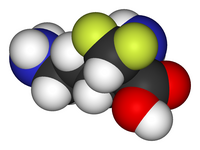二氟甲基鳥氨酸
 | |
 Enantiomer R of eflornithin (top) and S-eflornithin (middle) | |
| 臨床資料 | |
|---|---|
| AHFS/Drugs.com | Monograph |
| 核准狀況 |
|
| 懷孕分級 |
|
| 给药途径 | Intravenous (discontinued) Dermal |
| ATC碼 | |
| 法律規範狀態 | |
| 法律規範 |
|
| 藥物動力學數據 | |
| 生物利用度 | 100% (Intravenous) Negligible (Dermal) |
| 药物代谢 | Not metabolised |
| 生物半衰期 | 8 hours |
| 排泄途徑 | Renal |
| 识别信息 | |
| |
| CAS号 | 70052-12-9 |
| PubChem CID | |
| ChemSpider | |
| UNII | |
| KEGG | |
| ChEBI | |
| ChEMBL | |
| CompTox Dashboard (EPA) | |
| 化学信息 | |
| 化学式 | C6H12F2N2O2 |
| 摩尔质量 | 182.2 g/mol |
| 3D模型(JSmol) | |
| |
| |
二氟甲基鳥氨酸(Difluoromethylornithine;DFMO)是一種藥物,也稱為依氟鳥氨酸(Eflornithine),製造者為賽諾菲-安萬特藥廠。它是鳥胺酸去羧化酶(ornithine decarboxylase;ODC)的抑制物,而ODC是生物體內合成多胺(polyamine)所需的第一個酶。
這種藥在使用上有許多變化,最初是為了治療癌症而發展出來,但是後來在癌症治療上沒有應用,反而是能夠用來對抗由布氏岡比亞錐蟲(Trypanosoma brucei gambiense)所引起的非洲人类锥虫病(African trypanosomiasis)西非類型[1]。後來又發現它能用來抑制毛髮生長。現在有一些科學家正在研究二氟甲基鳥氨酸在癌症治療上的功效[2]。
治療锥虫病的二氟甲基鳥氨酸以Ornidyl®作為商標名稱;除毛膏則是以Vaniqa®為名販售。
睡眠症的治療[编辑]
功能[编辑]
二氟甲基鳥氨酸是以自杀性抑制的方式來抑制鸟氨酸脱羧酶(ODC),這是一種調節細胞分裂的酶,專門催化多胺生物合成的第一個步驟。並且因此能夠殺死錐蟲。
二氟甲基鳥氨酸對於布氏甘比亞錐蟲(Trypanosoma brucei gambiense)的效用之所以會被人發現,是因為它能使昏迷的病患甦醒,二氟甲基鳥氨酸也因此稱為「復活藥」。
研究人員希望能夠以二氟甲基鳥氨酸來取代毒性過強、致死率過高,且不可使用於懷孕婦女的含砷藥物美拉胂醇(melarsoprol)。不過二氟甲基鳥氨酸仍然有一些副作用,包括造成下痢、腹痛與貧血,只是病人對此的耐受性較高,不需要因此停止用藥[3]。
生產[编辑]
二氟甲基鳥氨酸的供應有限,因為製造者認為這種藥品的生產不敷成本。安萬特藥廠(後來與賽諾菲合併)因此在1995年停止生產這種藥物,不敷成本的主要原因在於非洲人类锥虫病的病患大多屬於貧窮人口,這些人沒有能力支付任何醫療費用。
到了2001年,在無疆界醫師(MSF)組織、國際醫學非政府組織(NGO)以及世界衛生組織(WHO)的遊說之下,製造商同意恢復生產二氟甲基鳥氨酸、美拉胂醇與噴他脒(pentamidine),並且供應能夠滿足需求的產量。製造商與世界衛生組織之間達成了一個為期5年的協議,其中也包括無疆界醫師在藥品分配上的工作。在協議中,安萬特每年所要供應的藥物總價值是500萬美元。此外,生產Vaniqa®(見「除毛膏段落」)的必治妥施貴寶公司,也會提供給安萬特部分生產二氟甲基鳥氨酸所需的資金。這個5年協議在2006年終止[4]。
協議結束之後,賽諾菲-安萬特藥廠將會把生產技術轉移給其他願意持續生產二氟甲基鳥氨酸的工廠[5]。
世界衛生組織在2005年9月的報告中表示,位於印度海德拉巴的印度化學技術研究院(India Institute of Chemical Technology),以及位於美國德州的ILEX Oncology公司,同時以較為便宜的新方法生產二氟甲基鳥氨酸。世界衛生組織也表示ILEX Oncology正在實驗用來治療癌症,以及用來對抗锥虫病的口服配方。
劑量[编辑]
用來治療锥虫病時,二氟甲基鳥氨酸以每6小時50 mg/kg,共14天的劑量送入靜脈[6]。
除毛膏[编辑]
二氟甲基鳥氨酸也是毛髮生長的抑制劑,這種功效是在治療疾病時被發現,因為它會阻礙某些患者毛髮生長。後來並以Vaniqa®(浓度13.9%)為名販售。
在一份送交美國美國食品藥品監督管理局(FDA)的資料裡,顯示出使用Vaniqa®控制臉部毛髮的女性中,有58%得到了改善效果(5%的人毛髮幾乎或全清除;27%顯著改善;26%有改善),FDA的資料也顯示這種藥劑在更年期後(postmenopausal)的婦女中較為有效[7]。另一個關於安全性的報告發現,這種產品很少發生顯著的副作用,如粉刺、或乾癢,這份報告也顯示2%的使用者因為不良反應而停止使用[8]。
參考資料[编辑]
- ^ Pepin J, Milord F, Guern C, Schechter PJ. Difluoromethylornithine for arseno-resistant Trypanosoma brucei gambiense sleeping sickness. Lancet 1987;2(8573):1431-3. PMID 2891995
- ^ 鳥胺酸去羧化酶調節與計畫性細胞死亡. [2007-04-03]. (原始内容存档于2006-06-20). (页面存档备份,存于互联网档案馆)
- ^ 寄蟲筆記 3 -- 血液鞭毛蟲 -- 錐蟲. [2007-04-03]. (原始内容存档于2007-06-23). (页面存档备份,存于互联网档案馆)
- ^ 存档副本. [2006-06-17]. (原始内容存档于2006-08-29). (页面存档备份,存于互联网档案馆)
- ^ (西班牙文) 存档副本. [2007-04-03]. (原始内容存档于2007-04-08). (页面存档备份,存于互联网档案馆)
- ^ van Nieuwenhove S, Schechter PJ, Declercq J; et al. Treatment of gambiense sleeping sickness in the Sudan with oral DFMO (DL-alfa-difluoromethyl ornithine) an inhibitor of ornithine decarboxylase: first field trial. Trans R Soc Trop Med Hyg. 1985, 79 (5): 692–8.
- ^ Vaniqa package insert (PDF). [2007-04-03]. (原始内容存档 (PDF)于2008-12-17). (页面存档备份,存于互联网档案馆)
- ^ Hickman JG, Huber F, Palmisano M. Human dermal safety studies with eflornithine HCl 13.9% cream (Vaniqa), a novel treatment for excessive facial hair. Curr Med Res Opin 2001;16:235-44. PMID 11268707.
參見[编辑]
外部連結[编辑]
| ||||||||||||||||||||||||||||||||||||||||||||||||
